Thanks to Viking Ocean Cruises for inviting us along and providing this adventure! As always, all opinions are our own.
See all of our exploits aboard the Viking Star through the Baltic Sea here.
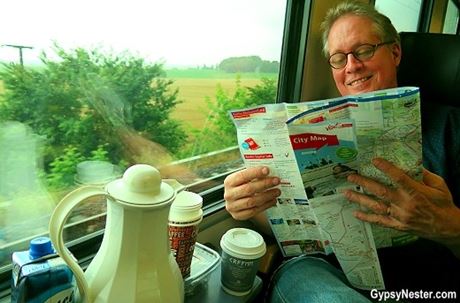 Berlin is not all that close to the sea, so as cruise passengers sailing the Baltic we had to ride the rails to visit the German capital.
Berlin is not all that close to the sea, so as cruise passengers sailing the Baltic we had to ride the rails to visit the German capital.
We generally jump at any chance (at least David does) to see some countryside through the window of a train, so off we went.
The train pulled into the Berlin Ostbahnhof, or east station, which is right by the East Side Gallery of the Berlin Wall.
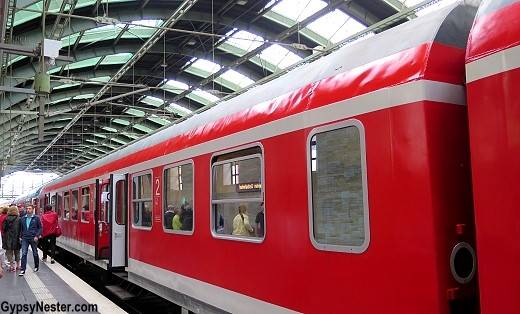
This is a nearly mile-long section of the Wall that has been covered with one hundred and five paintings by artists from all around the world.
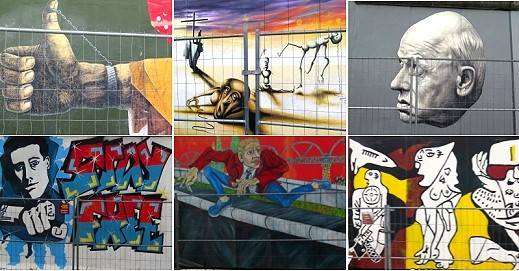 We immediately gravitated to perhaps the most famous of these works, Dmitri Vrubel’s picture of the one-time head of the Soviet Union Leonid Brezhnev and former East German leader Erich Honecker in full smooch mode.
We immediately gravitated to perhaps the most famous of these works, Dmitri Vrubel’s picture of the one-time head of the Soviet Union Leonid Brezhnev and former East German leader Erich Honecker in full smooch mode.

The Wall, a sympton of the partitioning of the city at the end of World War II, would play a primary role in the first part of our explorations, so we paralleled it toward the center of the city
The barrier was built to keep people in, not out, after three and a half million East Germans had fled to the West between 1946 and 1961. To stop the tide, an eight hundred and thirty-eight mile concrete border was erected.
The Berlin Wall was actually two parallel walls with a no-man’s land situated between them. We learned that towers were installed within eyeshot of each other and overseen by armed guards with orders to shoot to kill anyone who made it over the first wall.
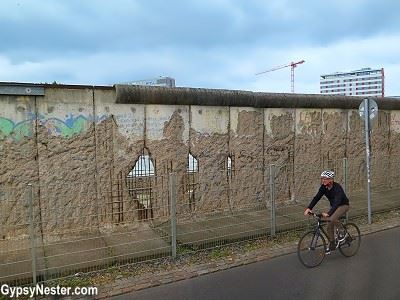
Every morning, the dirt in the no-man’s land would be carefully raked, and if any footprints were found without a dead body nearby, the guards would be punished.
After the East Germans built the wall in 1961, the allies were allowed three crossing points: Alpha, Bravo, and Charlie. Checkpoint Charlie, being the only one in the middle of the city, became the best known passage between the two German states.
Unfortunately, what we saw was only a replica, since the real guard house was removed and put on display at the Allied Museum in 1990.
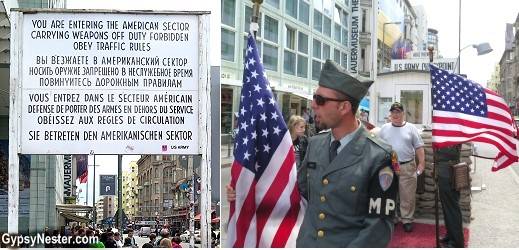
Moving on a few blocks from the checkpoint we found another section of the wall, one that has been left without embellishment. The concrete struck us as surprisingly thin—and the overall height much lower than we expected.
 This meant that additional measures were needed to keep people from breaking through.
This meant that additional measures were needed to keep people from breaking through.
In the patches where the concrete was worn we could see tight interlacing metal mesh, making it difficult to tunnel through. The top of the wall was rounded—then heavily greased—making it nearly impossible to climb over.
Another reason that this section of the wall was exceptionally interesting to us was because it runs right along the place where the Gestapo and SS once had their headquarters.
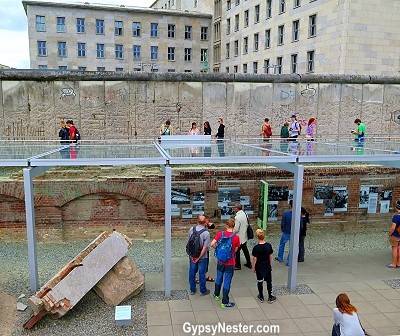 The buildings were completely destroyed by bombs at the end of the war, but the foundations have been used as a backdrop for a display detailing the history of repression under the Nazis.
The buildings were completely destroyed by bombs at the end of the war, but the foundations have been used as a backdrop for a display detailing the history of repression under the Nazis.
The gravity of this site, along with the incredibly disturbing information unfolding before us, created an overwhelmed feeling and our next stop only added to that.
The stark reality of the Memorial to the Murdered Jews of Europe served to increase the heaviness of the atmosphere, if that was possible.
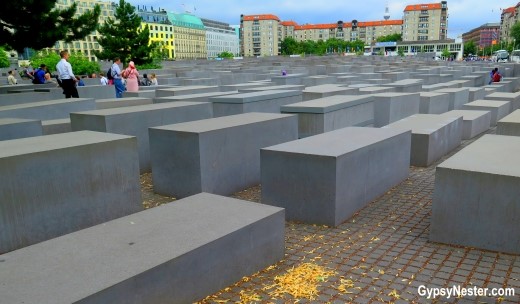
The concept of 2,711 concrete blocks of various heights was designed to show how a supposedly ordered system can lose touch with reason, but the creators also wanted the interpretation to be open to each individual.
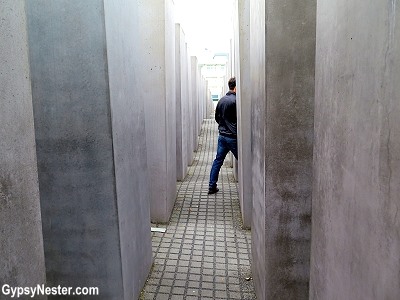 To us it certainly captured the weight of the events that it memorializes.
To us it certainly captured the weight of the events that it memorializes.
Walking toward the Unter den Linden, the main boulevard through the center of town, we stumbled upon yet another reminder of this city’s darker days.
Down a side street stood the last remaining watchtower from the days of the German Democratic Republic, better known as East Germany.
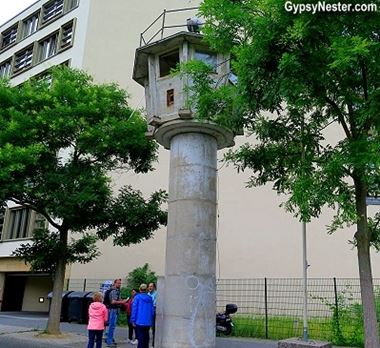 Of course, had it actually been democratic, or a republic, towers like this would not have been necessary in the first place.
Of course, had it actually been democratic, or a republic, towers like this would not have been necessary in the first place.
With all of the dark history we had consumed this morning, we decided an attempt to lighten up our mood was in order, so we stopped for a quick bite.
In Berlin that means a currywurst.
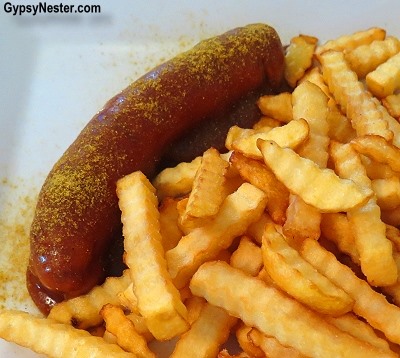 Just as the name implies, this is a twist on the typical German sausage by smothering it with catsup and curry powder.
Just as the name implies, this is a twist on the typical German sausage by smothering it with catsup and curry powder.
The snack became popular after the war as street stands began to pop up all around town.
Feeling revived and ready to move on from the darker days of Berlin’s twentieth century history, we jumped back in to find the regal reminders of the imperial era of Prussia and Germany.
The most notable of these has to be the Brandenburg Gate.
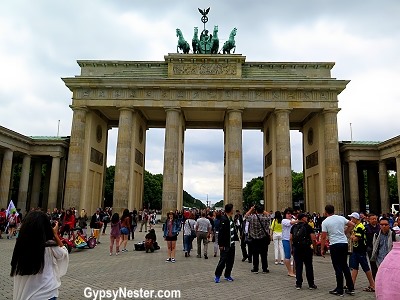 As with almost everything in the city, the gate was heavily damaged by bombing in World War II, but was restored after the end of the war, and then again once the wall came down. Since then it has become a powerful symbol of German reunification.
As with almost everything in the city, the gate was heavily damaged by bombing in World War II, but was restored after the end of the war, and then again once the wall came down. Since then it has become a powerful symbol of German reunification.
Another important symbol of prewar history and the reunification stands very near the gate, the Reichstag. After opening in 1894, it housed the government until 1933 when it was severely damaged in a highly suspicious fire.
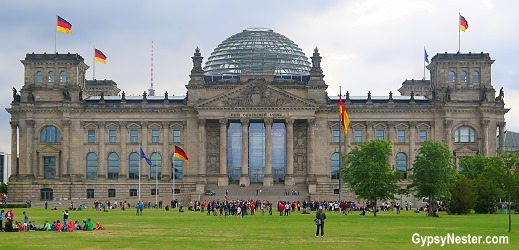
Hitler, who had been appointed Chancellor just one month earlier, used the blaze as justification to suspend most rights and begin an effort to eliminate communists and increase state security throughout Germany.
The building sat empty and fell into disrepair until it was partially refurbished in the 1960s, and then fully restored after reunification. Following that, it once again became the seat of the parliament.
Forging ahead through the heart of the city, we made a final stop at the Bebelplatz.
What seemed to be an insignificant plaza was the site of an infamous Nazi book burning in 1933. There is a memorial here but it is very easy to miss. We had to look pretty hard to find it.

The site is only marked by a window placed in the cobblestones looking down into a room filled with empty bookcases that would have held the 20,000 destroyed books.
The effect was certainly poignant, but by far the most powerful aspect of the memorial was a plaque set in the ground near the window with a scary, prophetic line from a play by one of the authors whose books were banned, Heinrich Heine.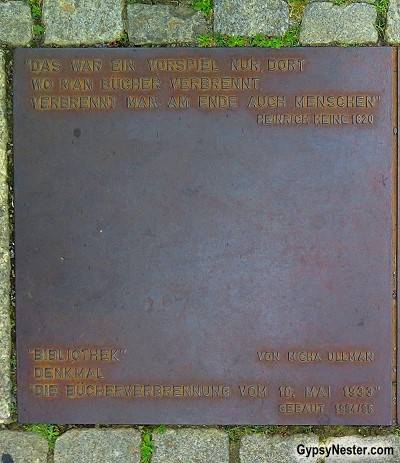
He wrote: “Das war ein Vorspiel nur, dort wo man Bücher verbrennt, verbrennt man am Ende auch Menschen.” Which means “That was only a prelude; where they burn books, they will in the end also burn people.”
From the plaza we made our way back to the station and the end of this distressing day of emotional and draining history.
Our train ride back to the ship was spent in somber thought.
David & Veronica, GypsyNester.com
See all of our exploits aboard the Viking Star through the Baltic Sea here.
Thanks to Viking Ocean Cruises for inviting us along and providing this adventure! As always, all opinions are our own.



I really liked your article. Will read on…
I could not refrain from commenting. Well written!
I’m really enjoying the design and layout of your site.
It’s a very easy on the eyes which makes it much more enjoyable
for me to come here and visit more often. Did you hire out a designer to create your theme?
Great work!
Love this. Brings back.memories of staying in a small town outside Nurnberg. Caught an early train and was whisked to Berlin. Walked around a few hours, catching the spots you mentioned, then headed back where we arrived late that night. A beautiful city I’d like to revisit with more time.